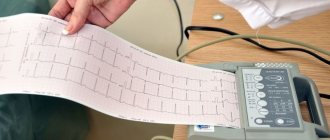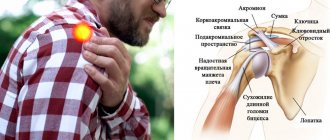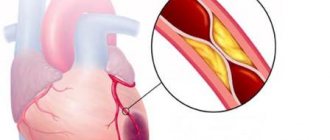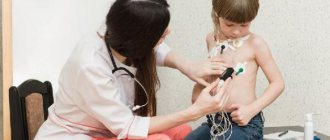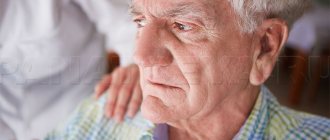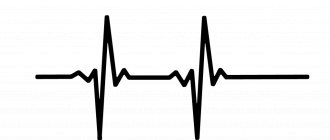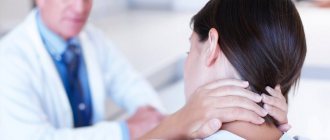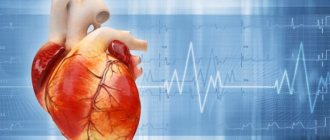Many patients come to the doctor with an “accurate” diagnosis, made independently. Without examination, they are sure that their heart hurts, and they are very surprised and even upset that the doctor does not detect signs of heart disease. On the one hand, this is even good, because people know about the danger and are trying to find out what to do if their heart hurts seriously.
On the other hand, such fear can lead to cardioneurosis, a brain disease in which pain in the heart is also felt.
Where is the heart
Not every person can show where his heart is located. Doctors use the phrase “pain in the heart area”, knowing in advance where this place is.
Typical heart pain occurs behind the sternum, in the upper part. Less common to the left of the sternum. In this zone there is a projection of the “main motor”.
But the costal arches with intercostal nerves are also located here, and the roots from the thoracic region are located behind the spine.
The pain may be associated with the pleura, which envelops the left lung.
Stomach ulcers, gastritis, and inflammation of the pancreas can cause constant pain in this area. They provoke pain in the epigastrium and lower part of the sternum.
You can massage the painful area yourself
Experienced excitement and stress leave behind a painful reaction. Therefore, do not rush to make a diagnosis. Tell your doctor in detail about your feelings, associated causes and connections with external influences. This will help you take the necessary measures and promptly recognize the true pathology of the heart.
Causes of heart pain
Pain is a defensive reaction: this signal is the first to draw attention to changes in the functioning of organs.
A painful sensation in the heart area (cardialgia) may signal one of the dangerous diseases of the heart or blood vessels that participate in its blood supply. Sometimes pain that appears to be heart pain is actually caused by other illnesses. The reason for this phenomenon is the location of the structures of the peripheral nervous system, the irritation of which causes pain. Chest pain can be associated with the spine, intercostal nerves, esophagus and even the skin.
Cardialgia can be imitated by:
- Diseases of the musculoskeletal system: osteochondrosis of the thoracic spine, pain in the intercostal muscles.
- Pathologies of the nervous system: inflammation of the intercostal nerves, non-inflammatory intercostal neuralgia, panic attacks; vegetative-vascular dystonia, psychosomatics (pain that occurs due to psychological reasons without objective disturbances in the functioning of organs).
- Vascular pathologies: aortic aneurysm (thinning and dissection of the vessel wall), pulmonary embolism (PE) - blockage of a vessel with a blood clot.
- Diseases of the gastrointestinal tract: pathologies of the esophagus, gastritis, stomach ulcers, pancreatitis and other diseases of the pancreas, diseases of the gallbladder.
- Respiratory dysfunction: pneumonia (inflammation of the lungs), pleurisy (inflammation of the film of connective tissue that covers the lungs and chest from the inside), bronchial asthma, pneumothorax (penetration of air into the cavity where the lungs are located), tuberculosis and other pulmonary diseases.
- Pathological manifestations on the skin: herpes zoster (infection with the herpes virus in the form of a blistering rash).
Also, pain in the heart area can be a manifestation of the action of toxins - some narcotic substances and aggressive chemicals.
However, heart disease is suspected in every case of chest pain: first of all, it is necessary to exclude myocardial infarction, unstable angina, pulmonary embolism and other life-threatening heart diseases.
Risk factors for heart pain
First of all, it is important to assess the likelihood of cardiovascular disease: if it is high, any discomfort in the patient’s heart area may be a sign of acute pathology.
Risk factors for cardialgia can be divided into uncontrolled (which cannot be corrected) and controlled (lifestyle features, nutrition, medication, treatment of concomitant diseases).
Uncontrollable risk factors include:
- age over 55 years;
- male gender;
- genetic predisposition;
- racial characteristics.
Acquired risk factors most often arise due to non-compliance with the principles of a healthy lifestyle. Poor nutrition, lack of physical activity, smoking, emotional reactions to stress, alcohol abuse and other bad habits significantly increase the risk of cardiovascular disease.
Also controllable risk factors may be associated with concomitant diseases and borderline conditions. These include:
- overweight and obesity;
- high blood pressure;
- diabetes mellitus and prediabetes;
- imbalance of blood lipids.
On the other hand, there are positive factors that prevent the development of cardiovascular diseases (Fig. 1).
Figure 1. Factors that influence the development of cardiovascular diseases Source: MedPortal
Chest pain in children
Acquired heart pathologies in childhood are a rare situation. Pain in the heart area in children is most often associated with congenital conditions or diseases that are not related to the cardiovascular system:
- congenital heart defects;
- diseases of the gastrointestinal tract;
- neuralgia;
- inflammatory processes in the lungs;
- chest injuries.
Young children cannot indicate the specific point where the heart hurts or describe their sensations. Therefore, parents should be extremely careful to recognize alarming symptoms in time and consult a doctor.
Heart pain during pregnancy
Cardialgia during pregnancy is not always associated with cardiac disorders. Most often, discomfort in the chest of the expectant mother is associated with adaptation: the vessels of the unborn child are built into the woman’s circulatory system, and the heart needs to “rebuild” to perform its functions in new conditions.
Also, the cause of heart pain during pregnancy can be:
- anemia,
- toxicosis and gestosis - severe pregnancy,
- intercostal neuralgia,
- disturbances in the reactions of the nervous system,
- cardiomyopathy.
Heart pain can seriously frighten a pregnant woman. But don’t panic: in such a situation, it is important to remain calm and go to the hospital immediately.
How does “non-cardiac” pain feel to the left of the sternum?
Let's look at the main causes that mimic heart pain.
Intercostal neuralgia, osteochondrosis
With intercostal neuralgia and osteochondrosis of the thoracic spine, the appearance of pain is more often associated with hypothermia, sudden lifting of weight, prolonged uncomfortable body position, bruise of the chest (rib fracture). They can be very intense (to the point of tears). They intensify with a deep breath, with the slightest movement of the body. During palpation, the most painful place is detected along the rib or near the spine.
Pleural involvement
The pleura is damaged by chest trauma, is involved in the inflammatory process against the background of lobar pneumonia, and reacts with effusion in allergic manifestations.
Compare the left and right sides: on the left, pleural plaque covers the lower ribs
The most severe damage is contamination of the pleura with malignant metastases from the tumor. The pain is constant, quite severe, and is associated with coughing and breathing.
Neurosis
Cardioneurosis is characterized by other signs of unrest: increased sweating, agitation, hand tremors, insomnia. The pain to the left of the sternum is dull, constant or stabbing in nature and is not relieved by heart medications.
They are more often observed in emotional women or in strong people who strive to maintain apparent calm.
Diseases of the stomach and pancreas
Diseases of the digestive system, as a rule, have, in addition to pain, other manifestations: heartburn, nausea, bloating, vomiting, and broken stools. Pancreatitis is characterized by a girdling direction of pain.
There is always a connection with the timing of meals and non-compliance with the diet.
Treatment
Help before diagnosis
Tingling in the heart is usually provoked by psycho-emotional factors, so it is advisable to use light herbal sedatives. To get rid of signs of neurosis, it is necessary to normalize your daily routine and diet, increase physical activity and time spent in the fresh air. If a person is diagnosed with coronary artery disease, to eliminate the stabbing pain, you need to take fast-acting vasodilators prescribed by your doctor.
Conservative therapy
Tingling rarely reaches such intensity that there is a threat of painful shock and emergency measures are required. The main thing in treatment is the elimination of the etiological factor. After successful treatment of the existing disease, the tingling in the heart disappears. The drug treatment regimen is selected individually according to the type of pathological process. The following drugs are used:
- Sedatives
. Medicines that act on the central nervous system are effective for cardioneuroses. They quickly stabilize the psycho-emotional background and eliminate increased anxiety. To eliminate neurotic disorders, their long-term use is required. - Muscle relaxants
. The drugs are widely recommended to combat pain caused by neuralgia and osteochondrosis. They affect peripheral nerve endings and reduce painful muscle tension. - Antiarrhythmic medications
. To normalize heart rhythm, cardiologists use 4 classes of medications. Medicines are selected taking into account the nature and severity of the arrhythmia, the presence of concomitant diseases of the cardiovascular system. - Anti-inflammatory drugs
. Medicines from the group of nonsteroidal anti-inflammatory drugs are indicated for myocarditis and other infectious processes, joint diseases. If therapy is insufficiently effective, glucocorticoids are prescribed.
For the targeted action of medications for neuralgia and joint damage, the electrophoresis technique is effective. To reduce tingling and pain of neurological origin, physiotherapeutic treatment is carried out - laser therapy, UHF, magnetic therapy. For neuroses, individual and group sessions with a psychotherapist are required.
Causes of true heart pain
True heart pain occurs due to malnutrition of a certain area of the heart muscle. This is possible with:
- spasm of the coronary vessels, their impaired tone, incorrect reaction (hypertension, vegetative-vascular dystonia);
- inflammation of the myocardium (myocarditis);
- the occurrence of ischemia from a pronounced atherosclerotic process or thrombosis;
- myocardial dystrophy and cardiosclerosis;
- heart defects;
- chronic heart failure.
Ischemic pain is most pronounced in acute myocardial infarction. They are intense, retrosternal, last up to a day or more, and are accompanied by pallor and a drop in blood pressure.
Angina pectoris often depends on physical or emotional stress. Substernal pressing pain radiates to the left, to the shoulder, shoulder blade, jaw.
Other heart diseases cause long-term, intermittent, dull or stabbing pain with varying degrees of radiation. Accompanied by arrhythmia, increased blood pressure, body temperature, dizziness, and general weakness.
Women often complain with complaints during menopausal changes in the body. Here the pain is caused by a lack of sex hormones. They are provoked by anxiety and poor nutrition. Accompanied by many vivid emotions: fear of death, suffocation (without increased breathing), darkening of the eyes, interruptions in rhythm, sweating. In men, menopause also matters, but it usually occurs later and coincides with the development of atherosclerosis and true ischemia.
How to distinguish heart disease from others
Many people experience chest pain not necessarily due to any heart disease. Often this occurs due to another illness. If your heart hurts, it can be caused by diseases of the musculoskeletal system, respiratory, digestive and other diseases. However, only a doctor can make an accurate diagnosis after examining the patient.
But any person who has experienced such signs should understand if the heart hurts, what to do and how to recognize that it really is a heart disease. You need to know this in order to promptly consult a specialist in case of some serious pathologies. The signs of the disease may vary; you must learn to recognize them. The most important thing is to distinguish between cardiac and non-cardiac pain. For this purpose, you need to know the duration and intensity of the attack. In addition, it is advisable to have information about other diseases whose symptoms are similar to those of the heart.
The first symptoms of a heart attack
Discomfort in the chest can occur for various reasons. To understand that the heart hurts, it is advisable to know several characteristic symptoms. Seizures are not always accompanied by unpleasant sensations. At the same time, people with other ailments complain that they have difficulty breathing and pain in the left side of their chest. But all this is not a consequence of cardiac diseases.
The earliest signs that indicate that the functioning of the human body’s motor system is impaired most often appear several months, or even years, before the first attack. Therefore, everyone should know how and where the heart hurts. Early signs of the disease that should alert you are:
- Painful sensations behind the ribs. They hit the back, arm, neck, teeth. The left side is most often affected. At the same time, there is shortness of breath, nausea, and increased sweating.
- Discomfort after physical activity, stress, which disappears after rest or nitroglycerin tablets.
- Shortness of breath appears even with moderate exertion, simple work, while eating, and even in a lying position. Before the attack begins, the patient may sleep while sitting or suffer from insomnia.
- Severe fatigue from usual activities can begin long before the first attack.
- Representatives of the stronger sex sometimes develop erectile dysfunction several years before the diagnosis of coronary artery disease.
- Swelling. This symptom is considered the most basic evidence of cardiac dysfunction. At first, the swelling is almost invisible, but becomes larger over time. This is noticeable when a person removes shoes or rings from their fingers. If swelling is observed, you should consult a specialist and undergo an examination.
- Stopping breathing during night sleep, as well as snoring. These signs indicate a predisposition to an attack of heart disease.
Signs of coronary diseases
1. Myocardial infarction
Heart attacks can occur in different ways and how the heart hurts , symptoms in women and men in different situations can be different. In the case of myocardial infarction, everything happens approximately like this:
- There is a feeling of heaviness, pain in the central part of the chest, arm.
- Discomfort spreads to the left arm, neck, throat, and lower jaw.
- You feel dizzy, sweating, your skin becomes paler, and you feel nauseous.
- There is a feeling of heaviness in the stomach, a burning sensation in the chest.
- Anxiety, weakness.
- Rapid pulse.
The course of a heart attack may be different. Sometimes there are no signs at all. Sometimes the patient says that he experiences discomfort in the chest, sometimes there are no such symptoms and the process can be painless. Signs of a major heart attack: shortness of breath, blue lips, etc. very similar to symptoms of acute heart failure.
The duration of such an attack is approximately thirty minutes. Nitroglycerin doesn't help at all.
2. Ischemia
The main manifestation of IHD is angina attacks. In this case, pain occurs in the heart; the symptoms are the same in women and men. Among them:
- cardiopalmus;
- dyspnea;
- cardiac dysfunction;
- inconsistent pulse;
- dizzy, nauseous;
- weakness, sweating.
With coronary artery disease, patients report that they have a burning sensation and pressure in their chest. There is a feeling of being overwhelmed. Often unpleasant sensations are transmitted to the arm, neck, and throat. Most often observed during physical activity, stress and stop when the person remains alone.
With angina at rest, pain in the heart, the causes of which are different, appears at any time, even at night. This form is considered unfavorable.
Inflammatory heart diseases
1. Pericarditis
Pericarditis is an inflammation of the outer lining of the heart, the main symptom of which is a dull pain in the heart area. The pain is usually in the center of the chest, in some cases it radiates to the arm, back, and neck. When swallowing, coughing, etc. discomfort intensifies. Lying down makes it worse, sitting up makes it better. Although the nature of the soreness is usually dull and aching, in some cases it can be acute. Pericarditis is also characterized by rapid heartbeat.
2. Myocarditis
Inflammation of the myocardium is one of the reasons why the heart hurts; approximately 90 percent of people complain about it. Its form can be different, it appears regardless of physical activity, but after some time it can become stronger. Nitroglycerin doesn't help.
Heart valve diseases
If valve disease is present, its severity cannot be judged by symptoms. The patient may not complain about anything and still be in serious condition. Main symptoms:
- Shortness of breath, which is observed not only during high loads, but even during the most usual activities and in a supine position;
- Discomfort in the chest during exercise, breathing in cold air;
- Weakness, dizziness;
- Heart rhythm disturbance. These are, in particular, an uneven pulse, rapid heartbeat, and disturbances in the functioning of the heart.
This pathology often leads to heart failure. Then the following symptoms appear: the legs swell, the stomach bloats, and body weight increases.
Cardiomyopathy
Almost all people who have this pathology complain of pain. As the disease progresses, the way the heart hurts and the symptoms change. At first, the pain is long-lasting, does not depend on physical activity, and nitroglycerin does not help. Feels in different places. Then it is spontaneous or paroxysmal in nature after exercise and most often goes away after taking a nitroglycerin tablet. Its character can be different, its localization is precise, but sometimes it spreads over a large area. Nitroglycerin does not always help.
Arrhythmia
There are several types of arrhythmias. They are characterized by changes in heart rhythm. There are several types of ailments that cause heart pain radiating to the left arm.
Heart defects
These diseases can be acquired or inherited. For a long time they may not talk about themselves. Sometimes your heart hurts; your doctor should tell you what to do. This pain is usually aching, cutting or stabbing in nature. Accompanied by high blood pressure.
Mitral valve prolapse
Aching or pressing pain that appears on the left side is not caused by physical activity. They do not stop after taking nitroglycerin. In addition, dizziness, rapid heartbeat, and headaches may occur in the morning and evening. Possible shortness of breath, lightheadedness.
Aortic stenosis
With this disease, there is a pressing sensation in the chest. There is a strong heartbeat, weakness, fatigue, shortness of breath during physical activity. Over time, shortness of breath and dizziness occur during night sleep. If you suddenly change your body position, you may faint. Attacks of asthma and angina pectoris are possible.
Thromboembolism of the pulmonary artery
This is a very serious condition that requires immediate attention. The first sign of the disease is a stabbing pain in the heart area, which becomes stronger when inhaling and does not radiate to other places. The patient's skin turns blue, blood pressure decreases, shortness of breath and rapid heartbeat appear. Nitroglycerin has no effect.
Aortic pathologies
Sudden, very strong painful bursting sensations in the chest are a consequence of aortic dissection. They are sometimes so painful that a person can lose consciousness. The patient needs emergency medical care.
If there is an aortic aneurysm, there is aching or throbbing pain in the heart, a specialist must decide what to do. If an aneurysm ruptures, the pain becomes unbearable. If measures are not taken, death may occur.
Non-cardiac diseases
1). Intercostal neuralgia. Many people who feel such pain in the heart area mistake it for heart pain. However, in reality they are different. With neuralgia, the pain is sharp and stabbing in nature. They intensify when coughing, deep breathing, sudden turns of the body, etc. This can go away quite quickly, sometimes the pain lasts for several hours. The patient can accurately determine the location of the discomfort; it is located between the right ribs. In the case of angina pectoris, a person experiences a burning, aching feeling that does not go away when the position of the body changes. It is impossible to determine the exact location.
2). Osteochondrosis. This disease is quite easy to mistake for angina pectoris. The person is sure that his heart hurts, the symptoms are as follows: numbness occurs in the left hand, and it becomes more painful when moving. All this is especially similar to angina pectoris when an attack occurs during night sleep. The main difference is that nitroglycerin does not work.
3). Diseases of the central nervous system. In such a situation, patients often complain. However, symptoms vary. This can be regular, short-term, acute or aching pain in the heart area. Neuroses, as a rule, are characterized by a variety of vegetative disorders. A person may experience anxiety, insomnia or, on the contrary, increased sleepiness. Your hands get cold or cold, your head starts to hurt, and much more. Often patients suffering from neuroses complain, talking about numerous symptoms that they do not actually experience. And the “core people” are very reserved in sharing their feelings. Sometimes it is difficult to understand whether a patient has ischemic heart disease or cardioneurosis, since the cardiogram does not show any changes.
4). Disturbances in the functioning of the gastrointestinal tract. However, in this case, heart pain symptoms are somewhat different. They last longer, and the person feels nauseous, vomits, and develops heartburn. The intensity is determined by food intake. Often the symptoms of acute pancreatitis are similar to myocardial infarction. Sometimes exacerbations of gallbladder diseases radiate to the left half of the chest and it seems that the pain is in the heart. To understand what the problem is, you should take antispasmodics. If relief occurs, then the patient has gastrointestinal diseases.
5). Pulmonary diseases. Painful sensations similar to heart pain sometimes appear with pneumonia. This can also happen with pleurisy. But in this case, the pain is acute, intensifying with inhalation and coughing.
What to do?
Every person who feels pain in the chest thinks about what to do next. If there is any suggestion that your heart is hurting, you need to take immediate action. After all, the cause may be serious, in particular myocardial infarction or an attack of angina. Therefore you need to do the following:
- You should calm down and sit down. A stressful state will only worsen the situation.
- You need to try to take a different position. If after this there is relief, there is a possibility that the reason is different. If the pain increases, a pressing pain appears in the heart area, there is a risk that it is angina pectoris.
- It is recommended to allow access to fresh air and open a window.
- To prevent breathing from being constricted, you need to make your clothes looser, unbutton your collar
- If you suspect angina, take a nitroglycerin tablet and place it under your tongue. If relief does not come within a quarter of an hour, you need to take another tablet. You should call for emergency assistance. The medicine does not work for a heart attack.
Finally
Even if the pain in the heart area, the cause of which must be determined by a specialist, has gone away, you need to go to the hospital as soon as possible and get examined. Self-medication is unacceptable.
In Nizhny Novgorod, you can undergo a preventive examination at the Road Clinical Hospital, where professionals work.
What to do if there is pain
Patients themselves know how to help themselves with pain in the heart due to a known disease; doctors teach them this. If you have pain, you should not take unfamiliar medications. Perhaps they are contraindicated for a particular person.
- If pain is accompanied by high blood pressure in a hypertensive patient, you should take quick-acting medications (dissolve under the tongue).
- For angina pectoris, sprays such as Isoketa are prescribed. Patients should carry them in their pocket with them. Nitroglycerin acts on the affected vessels, but is not well tolerated by everyone. Severe headaches are possible.
- At home, mustard plaster placed on the heart area and massage on pain points have a distracting effect.
Massage along the spine helps with osteochondrosis with pain
When to call an ambulance immediately
Here are the main 3 Types of Chest Pain That Won't Kill You signs that you need urgent medical attention:
- You experience severe, almost unbearable pain that does not go away for 5–10 minutes or more.
- Chest pain is accompanied by shortness of breath and difficulty breathing.
- The pain radiates to the left shoulder and arm.
- The pain is accompanied by cold sweat, dizziness, and severe weakness.
- You're pretty sure it's a heart attack. You are very scared.
The symptoms listed above may indicate serious problems. For example, the development of a heart attack, inflammatory heart diseases (myocarditis and pericarditis), diseases of the aorta, which supplies the heart with blood, or pulmonary embolism.
Each of these conditions is deadly, so you should not experiment with home remedies.
Only an ambulance!
Pain occurred for the first time
If pain occurs for the first time, the reasons are unclear, but it is necessary to relieve them somehow; the right choice would be such remedies as Valocordin, Corvalol (20 - 30 drops). Be sure to unfasten a tight collar, belt, belt so that you can breathe freely.
It won't hurt to take an aspirin tablet (chew and drink water) and rest.
First aid for heart pain should be included in the preparation of a home first aid kit, duplicated in the car enthusiast’s supply and at the dacha.
Treatment of heart pain
Pain is a symptom and therefore cannot be treated in itself. The method of therapy is selected only after determining the cause of pain.
Treatment begins with lifestyle changes: it is important to include all recommended ways to prevent heart disease in your list of daily activities.
Diet plays an important role: fried and fatty foods and sweets are excluded from the diet. The daily menu should contain a sufficient amount of fresh vegetables and fruits and fiber.
The patient is also offered to add physical activity to his daily routine - the duration and types of exercise are determined individually, depending on the identified disease.
Drugs for the treatment of heart disease are prescribed in a course or for long-term use. It is important to control blood pressure: for hypertension, medications must be taken daily, following the doctor's recommendations.
When to call an ambulance?
When there is no confidence in the correctness of the measures taken, you should not overestimate your knowledge; it is better to call an ambulance.
A special attitude has been formed towards people in a drunken state. They are not trusted even when complaining of severe heart pain. Do not leave such a person alone, although he may be very unpleasant. Call an ambulance and make sure the car has arrived.
If, despite help, it hurts severely for 15-20 minutes, rhythm disturbances or dizziness appear, you need to call an ambulance. Prolonged pain cannot be tolerated. The ambulance has ECG machines. It is possible to conduct an initial diagnosis to exclude acute infarction. The equipment includes painkillers.
The correct course of action: after the assistance provided, the patient felt improvement, but it is still necessary to undergo a full examination at the clinic, without waiting for repeated attacks. There is no need to joke with your heart.
